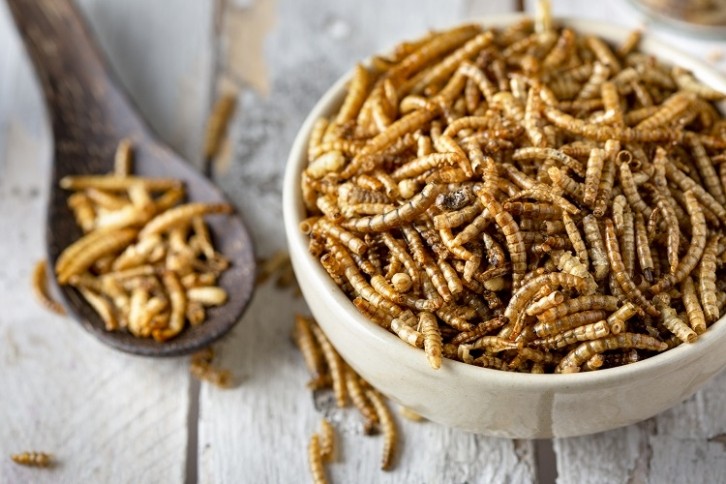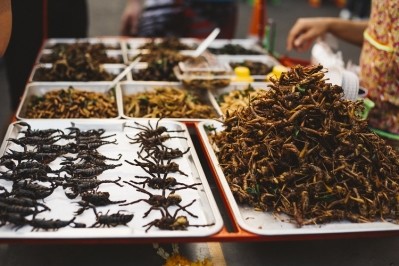Could eating insects slow weight gain in people with obesity?

Following positive assessments by the European Food Safety Authority (EFSA), a growing number of insect species are slowly crawling towards consumers’ plates. According to the regulatory authority, insect varieties including lesser mealworm larvae and house crickets are now deemed safe to eat.
From a sustainability standpoint, the advantages are clear. Compared to conventional animal protein, insects have a more efficient feed-protein conversion rate, can feed on agricultural by-products, and are associated with fewer greenhouse gas emissions and ammonia. Insect production also uses significantly less land and water: a gram of edible protein from beef requires 8-14 times as much land and approximately five times as much water compared to mealworms.
But there are nutritional benefits too. Crickets are thought to contain nearly three times the amount of protein content of beef. Other nutrients include fats, vitamin B, zinc, iron and fibre.
Now, researchers are investigating the impacts of insect consumption in mice.
The results are promising, according to lead study author Kelly Swanson, professor in the Department of Animal Sciences and interim director of the Division of Nutritional Sciences at the University of Illinois Urbana-Champaign, who believes more studies should be conducted to confirm these findings in humans.
“Our data show that mealworms may provide benefits beyond serving as a protein source, helping to manage weight and improve blood lipid profiles,” he told FoodNavigator.
Insect protein metabolically advantageous in obese mice
The study, sponsored by insect-based food and feed company Ÿnsect, saw one group of mice a high-fat diet (46% calories from fat) from dairy protein casein for a period of 12 weeks. After that, the diet was switched to insect-based alternative proteins. The control group of mice instead consumed a lean diet with casein throughout the experiment.
Researchers measured body weight, body composition, blood metabolites, and gene expression of the liver and adipose (fat) tissue during and after eight weeks on the experimental diets.
Findings suggest that replacing traditional protein sources with mealworms in high-fat diets could slow weight gain, improve immune response, reduce inflammation, enhance energy metabolism, and beneficially alter the ration of good to bad ratio.
But the researchers stressed that mealworm protein did not cause obese mice to lose weight. Rather, their rate of weight gain slowed, compared to the control group.
“It’s not a weight loss situation; they just slowed their gain with the mealworms,” explained Swanson. “The more significant impact was the improvement in their blood lipid profiles. Their LDL, so-called ‘bad cholesterol’, when down and the HDL, ‘good cholesterol’, went up.
“And from a gene expression perspective, inflammation when down and some of the lipid and glucose metabolism genes were altered. Not everything was positive, but metabolically, they were in a better place.”
It could be that some of the benefits are associated with the fibrous material that makes up the exoskeleton of insects, known as chitin. Although the role of chitin hasn’t been well studied, Swanson explained, it seems to act like a fibre, simulating beneficial microbial activity in the gut.
Could insect protein have the same impact on obese humans?
The study is not the first to evaluate alternative proteins for obesity weight management in mice. But to date, most have used genetically altered mice designed to remain obese in any situation. This study intentionally used ‘wild type’ mice, so that they would gain weight through diet, just as humans do.
As to whether the researchers’ findings could be applied to humans, from a regulatory perspective yellow mealworms are on the table. EFSA recognised the insect variety (Tenebrio molitor larva) as a safe ingredient by EFSA in late 2020.
Although Swanson acknowledges this latest study’s results are promising, he also contends that human studies should be conducted to confirm these results and identify the amount that is necessary to provide benefits.
Dr Nick Rousseau, managing director of trade body the UK Edible Insect Association, suggested the research findings were not surprising. “It is no surprise to us…that researchers are finding evidence that consumption of edible insects can have a positive impact on obesity, although the mechanism for this clearly still needs to be investigated, as well as its potential relevance for humans.”
The UK Edible Insect Association is ‘very pleased’ to see the growing body of research into many of the nutritional benefits of eating insects. Just 10g of crickets contain your daily dose of vitamin B12, crickets contain more than twice as much iron as spinach, almost five times as much magnesium as beef, three times as much iron, and supply more calcium than milk, we were told.
But do consumers want to eat insects?
But ‘ickiness’ associated with the consumption of insects remains in many countries where they have not traditionally been on the menu. “There’s a ‘yuck factor’ for many in Western societies, where eating insects is not quite normal, but some populations have relied on insect proteins for millennia,” said Swanson. “With protein shortages becoming a reality, there may be a place for insect meals.
“You’re not seeing legs or anything like that. It’s just a flour that shouldn’t negatively impact the taste or other properties of foods.”
Research into consumer perceptions around insect consumption is growing. Last year, research in the Netherlands found that compared to fish, plant-based meat alternatives, and cultivated meat, insects were perceived ‘significantly’ lower.
This year, a study published in Appetite found that the main opposition to eating edible insects ranged from disgust to neophobia (a fear of the new), but that in many cases the ‘hidden is best’ strategy – whereby consumers are not told of the presence of insects in food – would be optimal to reduce barriers to consumer acceptance. The average consumer willing to eat insects was found to be young and adventurous.
In the UK, the Food Standards Agency (FSA) recently conducted an online survey investigating awareness and perceptions of alternative sources of protein, including edible insects. When asked whether participants would be willing to try edible insects, one-quarter said they would.
Respondents were also asked how willing or unwilling they would be to try edible insects in different forms. Whole edible insects were least favoured. But when edible insects were ground into food for added protein, and incorporated into food products such as bread, burgers, or falafel balls, nearly two in five (37%) said they would give them a go.
Source: The Journal of Nutrition
‘Yellow Mealworm (Tenebrio molitor) and Lesser Mealworm (Alphitobius diaperinus) Proteins Slowed Weight Gain and Improved Metabolism of Diet-Induced Obesity in Mice’
Published online 16 June 2023
DOI: https://doi.org/10.1016/j.tjnut.2023.06.014
Authors: Yifei Kang Chaerine C. Applegate, Kelly S. Swanson et al.















